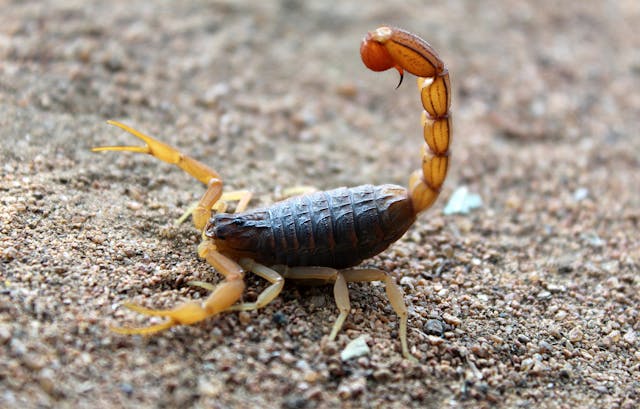
Scorpion Sting
Scorpion stings can be a frightening experience, especially if you’re unsure of what to do. While most scorpion stings are not life-threatening, they can cause intense pain, swelling, and other symptoms that require prompt attention.
In rare cases, certain species of scorpions, such as the Arizona bark scorpion, can pose serious health risks, especially to young children, the elderly, or those with compromised immune systems.
This article provides a step-by-step guide on what to do immediately after a scorpion sting, including practical first aid measures and when to seek medical help.
Step 1: Remain Calm and Assess the Situation
After being stung by a scorpion, the first thing to do is stay calm. Panicking can elevate your heart rate, which may cause venom to spread more rapidly through your system.
Assess your symptoms, focusing on the pain and any other immediate effects. It’s important to keep in mind that while scorpion stings can be painful, most do not result in serious complications.
Common Symptoms of a Scorpion Sting:
- Intense, localized pain at the site of the sting
- Swelling or redness around the area
- Numbness or tingling
- Muscle twitching near the site
- In rare cases: nausea, vomiting, difficulty breathing, or convulsions (especially with venomous species)
Step 2: Move to a Safe Area
If the scorpion is still present, move to a safe location to avoid additional stings. Scorpions are not typically aggressive, but they may sting again if disturbed or threatened.
Once you’re in a safe space, you can begin treating the sting.
Tip:
If possible, try to identify the scorpion, or take a photo of it, but do not attempt to capture or handle it. Identifying the species can help medical professionals assess the severity of the sting and decide on the appropriate treatment.
Step 3: Clean the Affected Area
The next important step is to clean the sting area. Use soap and water to thoroughly wash the site. Cleaning the wound helps reduce the risk of infection and clears away any venom on the skin’s surface. After cleaning, pat the area dry with a clean cloth or towel.
Step 4: Apply a Cold Compress
After cleaning the wound, applying a cold compress is an effective way to reduce pain and swelling. Wrap some ice or a cold pack in a towel and apply it to the sting site for 10-15 minutes at a time. This will help numb the area and alleviate discomfort.
Tip:
Avoid placing ice directly on the skin, as it may cause frostbite. Always use a cloth or towel as a barrier between the ice and your skin.
Step 5: Elevate the Stung Limb
If the sting occurred on an arm or leg, try to elevate the affected limb above the level of your heart. This can help reduce swelling by slowing the spread of venom and improving blood circulation. Keep the limb elevated while applying the cold compress to enhance relief.
Step 6: Take Pain Relievers
For most scorpion stings, over-the-counter pain relievers can be taken to help manage the pain. Medications such as ibuprofen or acetaminophen can provide relief from swelling and discomfort.
Tip:
Avoid taking aspirin, as it can thin the blood and may increase the spread of venom in the body. Always follow the dosage instructions on the medication’s packaging.
Step 7: Monitor for Severe Symptoms
In the majority of cases, scorpion stings will cause temporary pain and swelling that resolves within a few hours to a couple of days.
However, in some instances, especially when stung by venomous species like the Arizona bark scorpion, severe symptoms may develop. In these cases, seek immediate medical attention. Antivenom may be necessary, especially for high-risk individuals or those experiencing life-threatening reactions.
Step 8: Follow Up with a Doctor
Even if your symptoms are mild, it’s a good idea to follow up with a doctor, particularly if you’ve never been stung by a scorpion before. A healthcare professional can provide guidance on any additional treatments and ensure there are no complications, such as infection or delayed allergic reactions.
Prevention Tips to Avoid Future Scorpion Stings
While you can’t always prevent scorpion stings, taking certain precautions can help reduce your risk:
- Wear protective clothing (like gloves and boots) when hiking or working outdoors.
- Shake out shoes, clothing, and bedding before use, especially in areas where scorpions are common.
- Seal gaps and cracks around doors and windows to prevent scorpions from entering your home.
- Eliminate hiding spots, such as piles of rocks or firewood, near your house.
- Use insecticides or natural repellents if scorpions are prevalent in your area.
In Summary
A scorpion sting can be an alarming experience, but with the right steps, most cases can be managed at home. Begin by staying calm, cleaning the area, and applying a cold compress to reduce pain and swelling. Take over-the-counter pain relievers and monitor for any severe symptoms.
If the sting is from a venomous scorpion or severe symptoms develop, seek medical help immediately. By following these steps and taking preventative measures, you can minimize the impact of a scorpion sting and stay safe.






